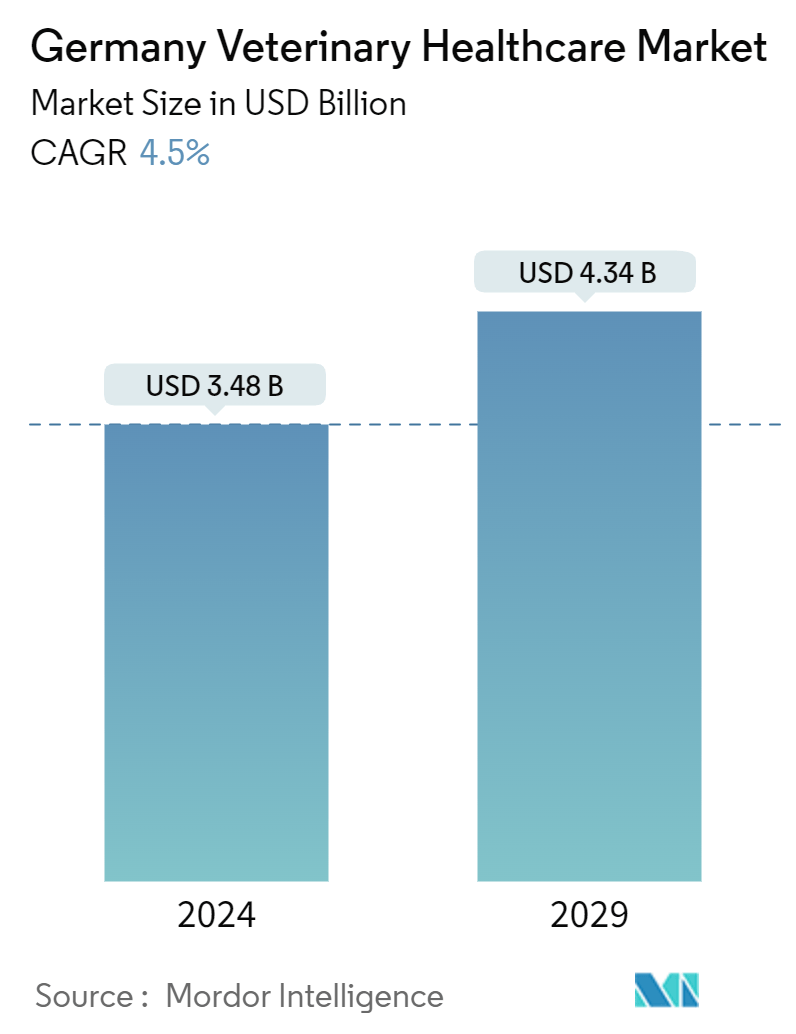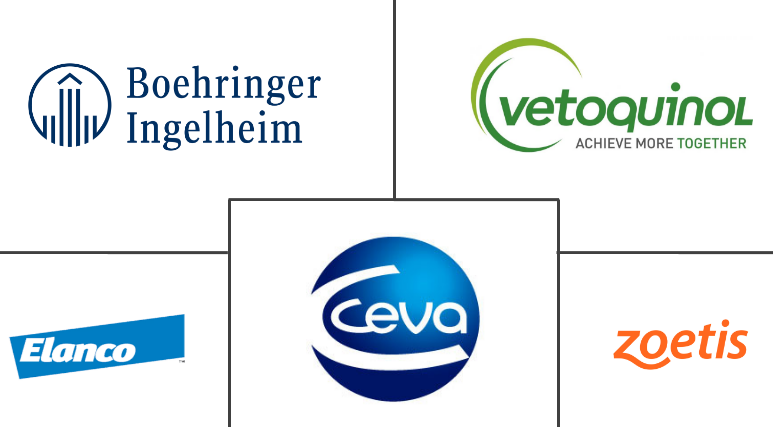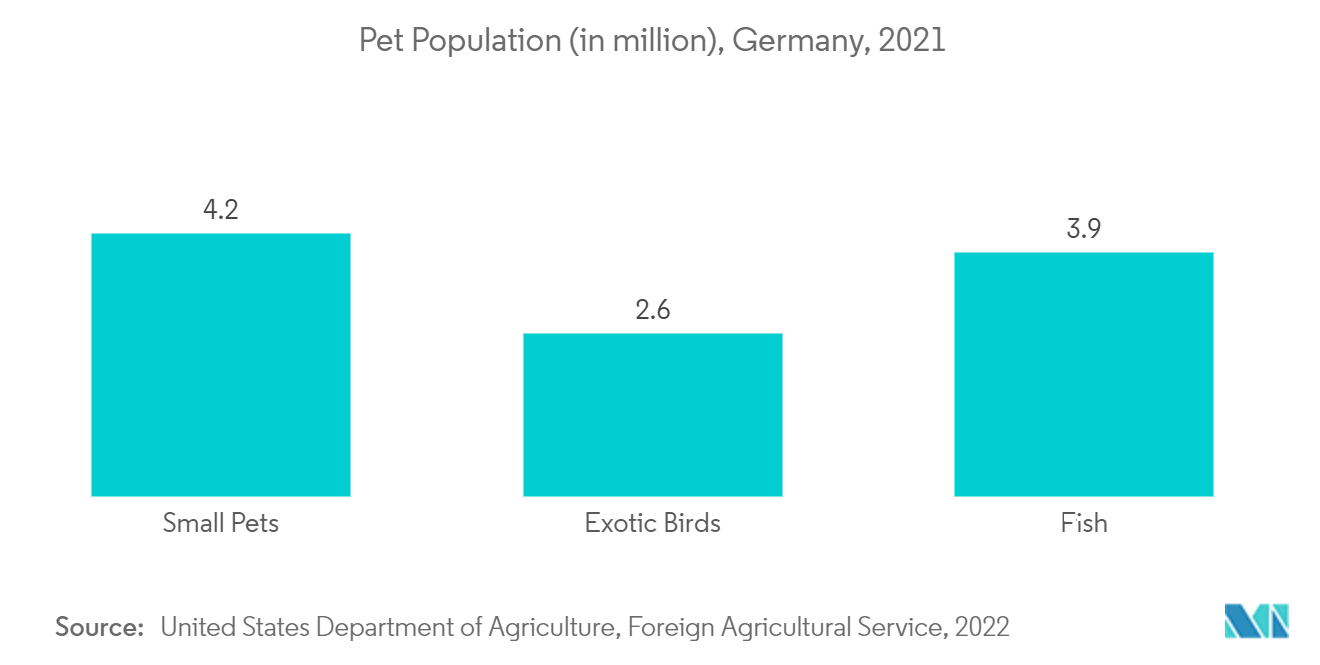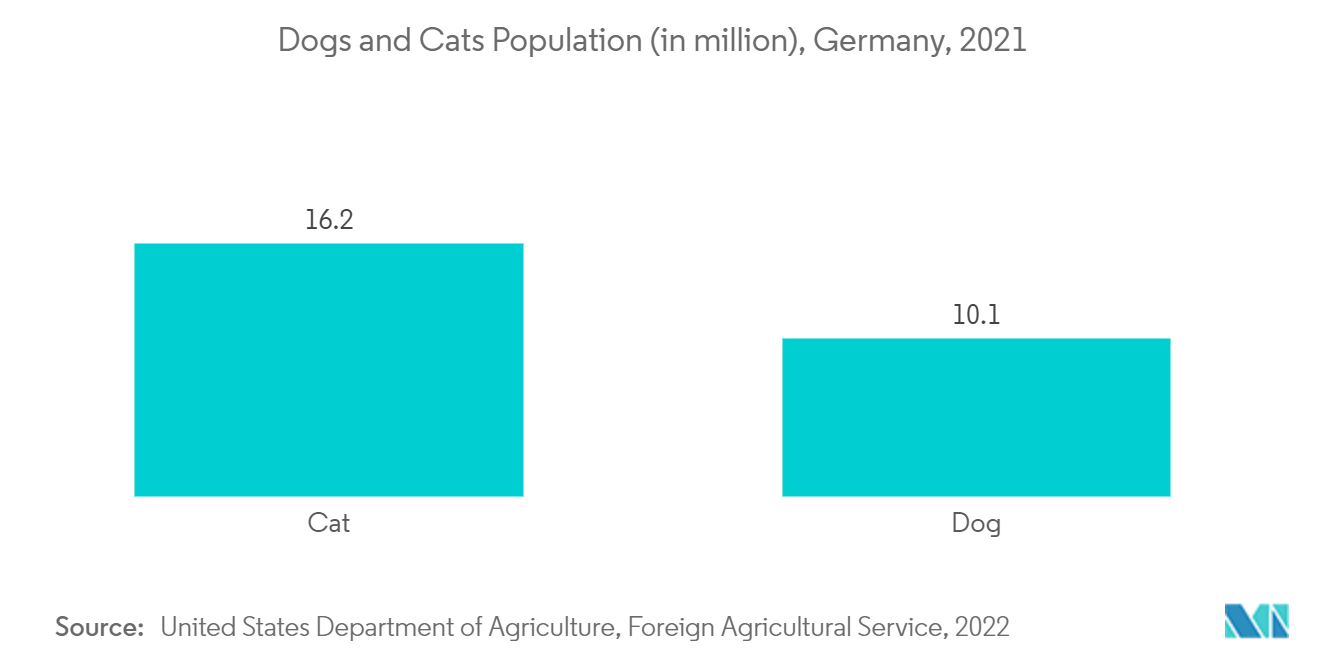Germany Veterinary Healthcare Market Size

| Study Period | 2019 - 2029 |
| Base Year For Estimation | 2023 |
| Market Size (2024) | USD 3.48 Billion |
| Market Size (2029) | USD 4.34 Billion |
| CAGR (2024 - 2029) | 4.50 % |
| Market Concentration | Medium |
Major Players
*Disclaimer: Major Players sorted in no particular order |
Germany Veterinary Healthcare Market Analysis
The Germany Veterinary Healthcare Market size is estimated at USD 3.48 billion in 2024, and is expected to reach USD 4.34 billion by 2029, growing at a CAGR of 4.5% during the forecast period (2024-2029).
The COVID-19 pandemic impacted the veterinary healthcare market by increasing the costs of animal testing and veterinary care. Supply chain disruptions and shortages of veterinary medicines were observed in several countries, primarily due to the temporary lockdowns of manufacturing sites, export bans, and increased demand for medicine for the treatment of COVID-19. For instance, according to an article published in February 2021, the demand for veterinary services and visits to pet clinics reduced in the country during the COVID-19 pandemic, impacting the growth of the veterinary healthcare market. Furthermore, according to a Health for Animals article, the World Veterinary Association (WVA) and regional veterinary organizations in Europe declared veterinary services to be essential in 2020, just like human healthcare services. As a result, a large number of veterinarians worked under the COVID-19 circumstances. The European Medicines Agency (EMA) created and implemented a few standards to guarantee the accessibility of veterinary medications on the German market. However, with pet clinic services resuming and the relaxation of COVID-19 restrictions, the German veterinary healthcare market is expected to grow over the forecast period.
According to Der Deutsche Heimtiermarkt, 47% of the households in Germany had pets in 2021. In addition, 34.7 million dogs, cats, small animals, and ornamental birds were kept by the population in the country. In Germany, laws and the veterinary administration work together to safeguard animal health. They guarantee good animal husbandry and cleanliness and efficient disease prevention and eradication efforts. It also confirms whether or not animals are given effective, authorized veterinary medicines. Therefore, it is projected that such occurrences will favor market growth in Germany throughout the forecast period.
The strategic initiatives adopted by key market players, such as product approvals, launches, partnerships, and acquisitions, are fueling the market growth. For instance, in July 2021, Boehringer Ingelheim revealed that the 2.0 version of the FreVAX smartphone app could control the FreVAX intramuscular needle-free device. It was developed to improve communication with the FreVAX system, a pig intramuscular needle-free vaccine injection device. Similarly, in November 2021, Felpreva (tigolaner/emodepside/praziquantel), to treat both internal and external parasite infestations for cats, was granted marketing authorization by the European Commission for marketing in Germany.
However, the increasing cost of animal testing and veterinary services is expected to hinder market growth.
Germany Veterinary Healthcare Market Trends
Vaccine Segment is Expected to Hold a Significant Market Share Over the Forecast Period
Vaccines comprise viruses, bacteria, and other disease-causing organisms that have been killed or altered so that they cannot cause any disease, boosting immunity. New advanced vaccines have been manufactured containing genetically engineered components derived from those disease agents.
Various market players are engaged in strategic initiatives such as product launches, approvals, and partnerships fueling the segment's growth. For instance, in March 2022, Boehringer Ingelheim launched the porcine parvovirus vaccine ReproCyc ParvoFLEX for healthy gilts and sowed six months and older. It offers practical and safe protection against reproductive failure brought on by porcine parvovirus. The innovation in the vaccine segment is estimated to propel the demand and its usage on a large scale to treat deadly diseases and ultimately add to the segment's growth.
Also, in April 2022, the PREVEXXION RN+HVT+IBD and PREVEXXION RN vaccinations for Marek's disease were launched by Boehringer Ingelheim in the EU nations, including the United Kingdom and Germany. As a result, these changes are projected to benefit the market, spurring segment expansion over the projection period.

Dogs and Cats are Expected to Hold a Significant Market Share Over The Forecast Period
Dogs and Cats are expected to hold a significant market share owing to the reasons such as rising adoption, rising pet healthcare expenses, and insurance facilities for pets.
The growing population and increasing adoption of dogs and cats by the German population is expected to increase the demand for their vaccines and the need for healthcare to prevent them from developing zoonotic diseases, which are anticipated to propel the segment growth during the forecast period. For instance, the European Pet Food Industry report reported 10,300,000 dogs and 16,700,000 cats in Germany in 2021. As per the same source, the estimated percentage of German households owing at least one cat was 21%, and one dog was 19% in 2021. This indicates that the adoption of cats was higher among the population than dogs. Pet adoption is estimated to propel healthcare expenses, boosting segment growth.
Furthermore, according to Der Deutsche Heimtiermarkt, 2022, the number of cats adopted was higher in Germany as compared to dogs, as 16.7 million cats live in 26% of German households compared to 10.3 million dogs in 21% of households. Also, from the same source, the number of mixed-breed dogs has increased from 42% to 44%. Germany is the European nation with the most significant number of cats and dogs as pets.
Thus, the increasing adoption of dogs and cats by the population in the country is expected to increase the demand for their therapeutics and diagnostics, which is anticipated to propel the segment growth over the forecast period.

Germany Veterinary Healthcare Industry Overview
The Germany veterinary healthcare market is moderately fragmented and consists of several major players. Companies like Boehringer Ingelheim International GmbH, Ceva Animal Health Inc, Elanco Animal Health, Idexx Laboratories, Merck & Co. Inc., Phibro Animal Health, Randox Laboratories, Ltd, Vetoquinol GmbH, Virbac SA, Zoetis, Inc, among others, hold the substantial market share in the Veterinary Healthcare market in Germany.
Germany Veterinary Healthcare Market Leaders
-
Boehringer Ingelheim International GmbH
-
Zoetis, Inc
-
Elanco Animal Health
-
Ceva Animal Health
-
Vetoquinol S.A.
*Disclaimer: Major Players sorted in no particular order

Germany Veterinary Healthcare Market News
- July 2022- Berlin-based Rex raised USD 5.27 million (EUR 5 million) to build veterinary clinics in the upcoming years. With an emphasis on customer experience, digitized processes, and top-notch treatment, the pet tech startup is bringing the digital world to veterinary care.
- January 2022- Idexx Laboratories Inc. launched a series of product and service enhancements, such as IDEXX 4Dx Plus Test, VetConnect PLUS Mobile App, SediVue Dx Urine Sediment Analyzer, and New Catalyst SDMA Test, that enable veterinary practices to be more efficient while managing increasing patient volumes. The enhancements provide deeper, actionable insights and personalized support to facilitate faster, more confident clinical decisions.
Germany Veterinary Healthcare Market Report - Table of Contents
1. INTRODUCTION
- 1.1 Study Assumptions and Market Definition
- 1.2 Scope of the Study
2. RESEARCH METHODOLOGY
3. EXECUTIVE SUMMARY
4. MARKET DYNAMICS
- 4.1 Market Overview
-
4.2 Market Drivers
- 4.2.1 Advanced Technology Leading to Innovations in Animal Healthcare
- 4.2.2 Rising Awareness and Initiatives by the Government
- 4.2.3 Increasing Prevalence of Zoonotic Diseases
-
4.3 Market Restraints
- 4.3.1 Increasing Cost of Animal Testing and Veterinary Services
-
4.4 Porter's Five Forces Analysis
- 4.4.1 Threat of New Entrants
- 4.4.2 Bargaining Power of Buyers/Consumers
- 4.4.3 Bargaining Power of Suppliers
- 4.4.4 Threat of Substitute Products
- 4.4.5 Intensity of Competitive Rivalry
5. MARKET SEGMENTATION (Market Size by Value in USD million)
-
5.1 By Product
- 5.1.1 By Therapeutics
- 5.1.1.1 Vaccines
- 5.1.1.2 Parasiticides
- 5.1.1.3 Anti-infectives
- 5.1.1.4 Medical Feed Additives
- 5.1.1.5 Other Therapeutics
- 5.1.2 By Diagnostics
- 5.1.2.1 Immunodiagnostic Tests
- 5.1.2.2 Molecular Diagnostics
- 5.1.2.3 Diagnostic Imaging
- 5.1.2.4 Clinical Chemistry
- 5.1.2.5 Other Diagnostics
-
5.2 By Animal Type
- 5.2.1 Dogs and Cats
- 5.2.2 Horses
- 5.2.3 Ruminants
- 5.2.4 Swine
- 5.2.5 Poultry
- 5.2.6 Other Animals
6. COMPETITIVE LANDSCAPE
-
6.1 Company Profiles
- 6.1.1 Boehringer Ingelheim International GmbH
- 6.1.2 Ceva Animal Health
- 6.1.3 Elanco Animal Health
- 6.1.4 Idexx Laboratories
- 6.1.5 Merck & Co. Inc.
- 6.1.6 Phibro Animal Health
- 6.1.7 Vetoquinol
- 6.1.8 Virbac SA
- 6.1.9 Zoetis, Inc
- *List Not Exhaustive
7. MARKET OPPORTUNITIES AND FUTURE TRENDS
** Subject To AvailablityGermany Veterinary Healthcare Industry Segmentation
As per the scope of the report, veterinary healthcare comprises the products used in the diagnosis and treatment of diseases in animals.
The Germany Veterinary Healthcare Market is Segmented by Product (Therapeutics (Vaccines, Parasiticides, Anti-infectives, Medical Feed Additives, and Other Therapeutics) and Diagnostics (Immunodiagnostic Tests, Molecular Diagnostics, Diagnostic Imaging, Clinical Chemistry, and Other Diagnostics), and Animal Type (Dogs and Cats, Horses, Ruminants, Swine, Poultry, and Other Animals). The report offers value (in USD million) for the above segments.
| By Product | By Therapeutics | Vaccines |
| Parasiticides | ||
| Anti-infectives | ||
| Medical Feed Additives | ||
| Other Therapeutics | ||
| By Product | By Diagnostics | Immunodiagnostic Tests |
| Molecular Diagnostics | ||
| Diagnostic Imaging | ||
| Clinical Chemistry | ||
| Other Diagnostics | ||
| By Animal Type | Dogs and Cats | |
| Horses | ||
| Ruminants | ||
| Swine | ||
| Poultry | ||
| Other Animals |
Germany Veterinary Healthcare Market Research FAQs
How big is the Germany Veterinary Healthcare Market?
The Germany Veterinary Healthcare Market size is expected to reach USD 3.48 billion in 2024 and grow at a CAGR of 4.5% to reach USD 4.34 billion by 2029.
What is the current Germany Veterinary Healthcare Market size?
In 2024, the Germany Veterinary Healthcare Market size is expected to reach USD 3.48 billion.
Who are the key players in Germany Veterinary Healthcare Market?
Boehringer Ingelheim International GmbH, Zoetis, Inc, Elanco Animal Health, Ceva Animal Health and Vetoquinol S.A. are the major companies operating in the Germany Veterinary Healthcare Market.
What years does this Germany Veterinary Healthcare Market cover, and what was the market size in 2023?
In 2023, the Germany Veterinary Healthcare Market size was estimated at USD 3.32 billion. The report covers the Germany Veterinary Healthcare Market historical market size for years: 2019, 2020, 2021, 2022 and 2023. The report also forecasts the Germany Veterinary Healthcare Market size for years: 2024, 2025, 2026, 2027, 2028 and 2029.
Veterinary Healthcare in Germany Industry Report
Statistics for the 2024 Veterinary Healthcare in Germany market share, size and revenue growth rate, created by Mordor Intelligence™ Industry Reports. Veterinary Healthcare in Germany analysis includes a market forecast outlook to 2029 and historical overview. Get a sample of this industry analysis as a free report PDF download.



